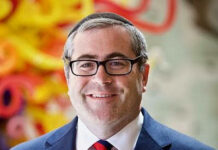Local clergy want to clear up one thing about the High Holiday season off the top.
It’s not just Rosh Hashanah and Yom Kippur. After those 10 days, the season continues through the week of Sukkot and the two days of Simchat Torah.
So, in the end, the High Holiday season lasts almost a month. And by the end of a season of long days, rabbis, cantors and synagogue leaders are often wiped.
Now, you may be inclined to believe that rabbis sleep at their synagogues just like teachers sleep at their schools. But just like with teachers, that is a myth. Just like teachers, rabbis have lives, too.
And come the end of the High Holiday month, they get to live them again. The 5782/2021 High Holiday season concluded Sept. 29 with Simchat Torah. Since then, area rabbis and cantors have emerged from their synagogues, breathed some fresh fall air and rediscovered their families and hobbies.

Cantor Lauren Goodlev of Beth David Reform Congregation in Gladwyne rediscovers her family in a profound way.
After a month of late nights planning services, sometimes emailing her rabbi, Beth Kalisch, as early as 3 a.m., Goodlev uses the fall to work on a more personal project: making a family photo album from the past year.
Goodlev has “three little babies at home,” as her oldest son is only three-and-a-half. So each year, her three boys grow and develop in visible ways, and she wants to make sure she chronicles that process.
On Shutterfly, Goodlev creates a digital album and fills it with family pictures. Then she pays for several and gets Shutterfly to send her the real books. Every year at Chanukah, she gives albums to her children’s grandparents as gifts.
She also keeps one for herself and her husband.
“With our cell phones, we take so many pictures,” Goodlev said. “Otherwise, they’ll get stuck in the cloud and we’ll never look at them again.”

Rabbi Abe Friedman of the Conservative Temple Beth Zion-Beth Israel in Philadelphia is in a similar situation as Goodlev. He’s the parent of four kids 13 and under, including a year-old daughter.
So once Simchat Torah ended, he started taking her to Fitler Square Park, on Pine Street between 23rd and 24th streets, every morning. Friedman does chalk art on the pavement for his daughter to observe.
Last week, on different mornings, he drew a Torah, a nature scene and a Shabbat scene, with candles, grape juice and challah.
“I fell into doing this because we were there in the park, and it just went from there,” Friedman said. “The weather’s been gorgeous.”
But for Friedman and his daughter, it’s not just mornings that they get to spend together. Now that the rabbi no longer needs to work seven days a week, he is his daughter’s primary caregiver on his day off.
And when she naps, daddy gets some me time. Friedman goes down in the basement to tinker in his electronics workshop, where he fixes pedals for electric guitars.
“It’s a little bit sad to see it go,” the rabbi said of the High Holidays. “But then it’s like, deep breath.”
Rabbi Solomon Isaacson leads the Orthodox Congregation Beth Solomon in Northeast Philadelphia. As an Orthodox rabbi, he has a different perspective than his Reform and Conservative contemporaries.
For Isaacson, the season requires almost no extra work besides giving speeches.
Beth Solomon is considered the largest Russian synagogue in the country, Isaacson said. It doesn’t have a membership model, but it helps thousands of families, and many attend Shabbat services throughout the year.
So when they show up for the High Holidays, they just open their prayer books and the services begin, like any Friday.
“You don’t have to tell them to stand up or sit down. You don’t have to call out page numbers,” Isaacson said. “They know what they’re doing.”
Isaacson did say that Yom Kippur is a little busier than other High Holidays, as non-Orthodox people come, too, and the crowd can reach up to 3,000 attendees. But otherwise, the season is no more hectic than the months before and after it.
The rabbi said the High Holiday month might be lighter than others because there’s less going on between services.
Once October came this year, Isaacson started planning and running more classes. Beth Solomon operates a small rabbinical college with seminars every morning and evening.
“We’re busy,” Isaacson said.
Another more traditional rabbi, Zalman Blecher of the Lubavitch of Yardley, a Chabad center, follows a similar annual rhythm. For Blecher, just like for Isaacson, the High Holiday month is not some climactic stretch on the Jewish calendar.
It’s the start of a new year.
Therefore, it’s not time to relax; it’s time to get going.
But Blecher, unlike Isaacson, does have to work extra during the High Holidays. He’s often up until 1 a.m. planning services, sermons and a marketing campaign to the public.
Yet Blecher tries not to slow down too much once the big days end. This month, the Lubavitch will resume weekly Torah classes, start a new class for moms and babies, hold Shabbat dinners and even conduct a nature hike at Tyler Park in Newtown.
“That’s how we’re going to channel that inspiration of the holiday season,” Blecher said.
[email protected]; 215-832-0740






